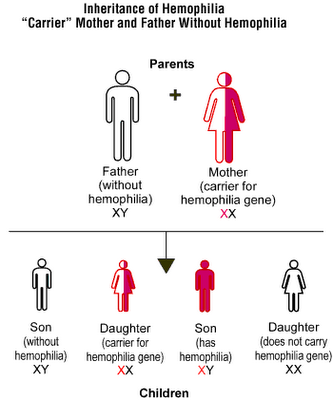Hemophilia is a genetically inherited disease caused by mutations in Factors VIII or IX, proteins that determine the blood's ability to clot. Factor VIII is considered the antihemophilic factor because it promotes proper blood clotting. People with Hemophilia A are those who produce too little or no Factor VIII, and they make up about 85% of the hemophilic population. Factor VIII is a relatively large protein, so mutations occur in the form of deletions (a segment of DNA is removed), point mutations (a single base pair in a DNA sequence, or only one of the "rungs of the ladder", is changed, inserted, or deleted), or inversions where part of the DNA has flipped backwards.
Factor IX is also known as the Christmas factor and mutations cause Hemophilia B. Mutations of this protein are usually deletion or point mutations.
In most cases, hemophilia is inherited by parent who either expresses or carries the mutation. However, there is a rare form of hemophilia known as Acquired Hemophilia. This occurs when a body begins to make specialized proteins called autoantibodies. They then mistakenly attack the coagulation factors. Usually Factor VIII is targeted, however Factors V and IX are also susceptible. The production of autoantibodies is associated with immune system disorders, viral infectious cancer, even allergic reactions to a drug or pregnancy. Basically, anytime the body is weakened. What causes the autoantibodies to attack the coagulation factors is unknown.
The pictures above show three different ways hemophilia can be inherited. You might have noticed that in none of the outcomes does a daughter express hemophilia. This is because hemophilia is transmitted on the X chromosome. In the case of a daughter, she would inherit one of her X chromosomes from her mother and one from her father. In most cases, the healthy chromosome, the one not carrying hemophilia, would negate the mutation of the unhealthy one. Men express the hemophilic gene because they only have one X chromosome. The absence of a healthy chromosome allows the gene to be expressed.
"
|
Wow, I just scrolled up through my post and realized how long and dry it sounds. I hope I didn't lose you along the way! Not all of my posts will be like this, but I do have to fulfill some requirements.
Sources Specific to This Post:
"Acquired Hemophilia." U.S. Department of Health and Human Services/Office of Rare Diseases Research, n.d. Web. 11 Feb. 2014.
"Factor XI Deficiency." The National Hemophilia Foundation, n.d. Web. 11 Feb. 2014.
"Hemophilia." ASGCT. American Society of Cell and Gene Therapy, n.d. Web. 11 Feb. 2014
"
|






No comments:
Post a Comment